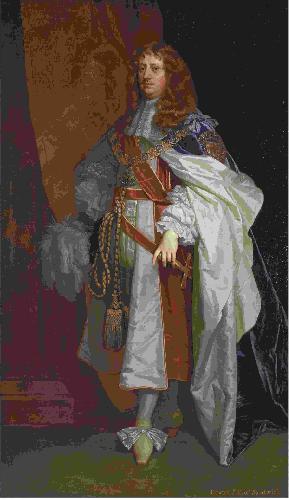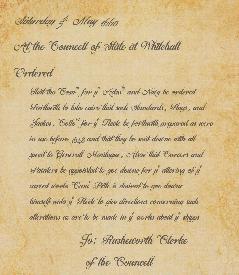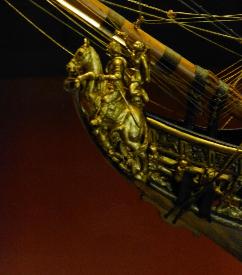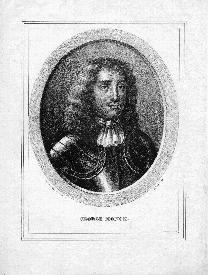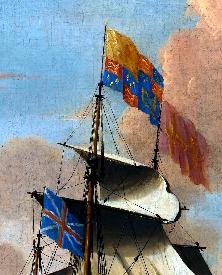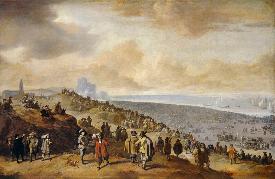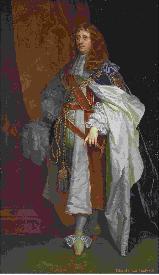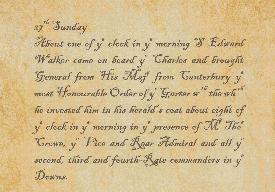GUEST POST - submitted by John Hawkins. John's new book, Tangier - the Earliest Battle Honour, explores the proto-British Empire in the English occupation of Tangiers. Visit his website on the early English Empire - http://www.englishtangier.co.uk
Introduction
Our amazing English libraries are guardians of an unbelievably extensive range of manuscripts and prints from a time when people kept diaries, when communication was by the written letter and delivery was by the packet system. Those in public office, and many others, kept the letters they received and often made copies of those they sent. A surprising number of these original letters and journals from private collections now reside in libraries or museums and are in most cases accessible to the public through membership of the appropriate establishment.
Whilst researching my book ‘Tangier' – Pen & Sword (November 2023) - I was impressed by the far-sighted actions of Edward Montague, 1st Earl of Sandwich, and resolved to discover more about this fascinating character.
One collection of his papers was purchased by the Caird Library of the National Maritime Museum a few years ago and is catalogued as SAN A 1-3. Volume 1 is fronted by contents pages, but anyone wishing to access the other volumes has to read each manuscript to determine its contents.
Whilst picking my way through Volume 3 of the Sandwich Papers in search of clues as to when Edward Montague first contacted Charles Stuart in exile, I found this gem catalogued as SAN A3 folio 208.
Transcript of SAN A3 f208, written a few weeks before Montague took the fleet to collect Charles Stuart from the continent for his restoration to the English throne.
I could see the need for Royalist flags rather than Cromwellian, but why carvers?
At length I discovered a model of Montague's flagship, the “Naseby”, in the National Maritime Museum, proudly displaying its figurehead.
Figurehead on the model of The Naseby representing Cromwell riding roughshod over other nations
National Maritime Museum, Greenwich
This prompted me to more research and to write the following narrative account of some of the events of May 1660.
11th May 1660
On board The Naseby
To the gathered captains Edward Montague, General-at-Sea, appeared the epitome of calmness.
A courageous man of strong principals, at the age of nineteen he had defied his father and raised a regiment for Parliament to fight against his king, Charles I. What had seemed a poor decision after Prince Rupert's successes at Edgehill and several subsequent battles looked a better bet after he had admired Oliver Cromwell's cavalry victorious at Marston Moor - even more so once Fairfax had established his New Model Army of professional soldiers.
Montague was proud of his own role in the subsequent victories at Naseby and Bristol which helped bring Prince Rupert's defeat and dismissal from the Royalist cause and the voluntary removal of Charles, Prince of Wales, to France which heralded the King's downfall.
Montague did not support the trial of the King and opposed his execution but, a fervent believer in the need for strong government, he backed Cromwell's firm stance and even supported his installation as king-in-all-but-name Lord Protector. In return Montague had been appointed to the Council of State. January 1656 saw him made a General-at-Sea in the powerful navy largely created and shaped by fellow General-at-Sea Robert Blake.
Montague had been sent to the Mediterranean to impose English will on the French Navy and the Corsairs of the Barbary Coast. His naval career looked promising but Oliver Cromwell's early death had thrown Richard Cromwell into the all-powerful position of Lord Protector. Montague had been despatched to the Baltic on a gunboat diplomacy mission, but the young Protector had shown himself incapable of controlling the army commanders and the struggle between them and Parliament led to Richard's resignation. As the country descended into chaos and anarchy some people began to think the unthinkable - the only way to restore peace to the country was to restore the sovereignty. Montague's father-in-law, John Crew, had spoken in confidence to him of the desirability of the King's return ‘under conditions' with constitutional safeguards, such as Parliamentary control of the militias. Later Montague himself had been accused of complicity with the exiled Charles Stuart and dismissed the service.
At Parliament's request General Monck had boldly marched his Scottish regiment south to London to restore order, brushing aside the threat from Lambert's army, and as de facto ruler of England had recalled Montague to the navy.
George Monck (Wikimedia Commons)
Throughout the troubles of the Civil War, the Commonwealth and Protectorate, Montague's far-sightedness and native wit - along with a large slice of luck - had seen him navigate his way through political storms that had wrecked many of his peers' promising careers, and now, at 35 years of age, he was watching expert ship-builder Pette direct his workmen to usher in a new reality - a new danger.
On board the pride of the English navy – the newest, largest, most destructive warship afloat – he was overseeing the death of Oliver Cromwell. Or, to be more accurate the great man's second death, his political death, the expunging of his presence from the forefront of the most potent navy in the world.
The Naseby – named for the battle where Charles I's Royalist Army was destroyed by the Parliamentarian New Model Army with Cromwell leading the prestigious cavalry in 1645 – had a magnificent figurehead. The intricate carving at the front of the ship portrayed Oliver Cromwell riding full speed, trampling enemy nations under the hooves of his steed. Hovering above him, a cherub held the approving wreath of fame over his head. Now the carvers were reshaping the figurehead and painters were changing Parliamentarian red to Royalist blue, green and gilt. Carpenters were wainscoting the Royal cabin and Turkish carpets were being selected to cover the planks whilst seamstresses were busy fitting the bed with finest linen and coverlets of gold and silver.
Detail from later painting showing the Royal Standard (between the British Union flag and Lord High Admiral's flag) Jacob Knijff, Public domain, Wikimedia Commons
Throughout the fleet union flags were being installed on bowsprits and red ensigns on stern posts. Sail-makers were measuring the flagship ready for cutting and stitching scarlet silk aprons to cover the ship's rails. Charles' royal standard was being prepared for hoisting high on the mainmast.
Montague's next voyage would be the most dangerous of his life. He had prepared the fleet as well as time allowed. He had paid off unsuitable captains who could not or would not move with the times, replaced militant Republican officers and removed below-decks rabble-rousers who might turn the tide of the ever-fluid emotions of the common sailors. He had ordered flags and jacks of the design used before 1648 and requested celebratory bunting and scarlet silk aprons for The Naseby.
A few days ago his Council of War, consisting largely of newly promoted Royalists, had unanimously approved the address they had received from Charles Stuart, all agreed their next undertaking, all cheered the new reality[1]. In a letter to Parliament he had been able to report the success of his delicate mission to ensure the navy's complete loyalty to His Majesty. Even now delegations from both Houses of Parliament were making arrangements to be shipped across to The Hague to demonstrate their new found loyalty by declaring Charles their King.
But Montague would not criticise these men as turncoats - changing situations demanded adjustments to one's approach. He was now convinced the only way to secure peace and harmony in England was to bring Charles Stuart back as Charles II. George Monck, commander of the only effective regiment in the country (who had reportedly considered using his army to usurp the ultimate power and seize the glory of Lord Protector) seemed to agree, and was apparently reconciled to the idea of restoring power to its rightful owner. There were even reports of Monck dining at the Skinners' Hall in the City of London with the King's arms above his chair[2]. Montague had just received a letter relating the surrender of the last potentially rebellious Troops of Horse without a shot fired[3]. The probability of continued strife and civil war had been averted, at least for the time being.
Montague himself had taken a leading role in arranging the restoration of the monarchy, most recently the negotiation of the Declaration of Breda. In this declaration Charles had publicly announced there would be no punishment meted out to those who had supported or fought for Parliament against his father. The only ones excepted from this amnesty were the regicides, those who had tried and executed Charles I. They could expect to be hunted down to face the ultimate punishment of public hanging and quartering.
He had heard that although Charles was keen on reconciliation and wholeheartedly wished to unite the country by encouraging people of different political beliefs and religious faiths to accept each other, Charles' brother, James, Duke of York, was less compliant. He wanted revenge on Parliamentarians and action against non-conformists. Montague told himself Charles was a fit and healthy twenty-nine year old and from what he had heard would sire many heirs, so James' views were of little consequence.
Montague forced himself to appear calm, as he turned and smiled to Edward, his son, and his nephew Pepys, who he had invited aboard for the journey to the United Provinces to bring Charles back as King of England. With any luck Charles would prove as grateful as he pretended in his recent letters and Montague would keep his lands and his position as General-at-Sea. He might even retain his seat in the Council of State and be instrumental in guaranteeing England's security and increasing wealth through growing trade. If, on the other hand, Charles proved vindictive then Montague's fellow conspirator, Monck, would be equally at risk and surely the two of them would be able to rely on the army and navy to keep them from harm long enough to organise their escape.
One thing was certain in his mind - the lives of a few regicides and a couple of hundred thousand pounds expenses were a small price to pay for the stability of a ruling sovereign.
[1] Parliamentary Intelligencer May 4th E183 No. 12
[2] Pepys Diary April 23rd 1660
[3] Sandwich MSS Letters i 23
27th May 1660
On board The Royal Charles
‘Knight of the Garter'. He liked the sound of that. Surely this supreme honour had put his forgiveness beyond all doubt and confirmed His Majesty's recent written words ‘I do assure you I am so far from remembering anything to your disadvantage that I look upon you as a person to be rewarded'[1]. At least it gave him confidence that he was safe for the time being. As safe as the King Himself – and who knew how safe His Sacred Majesty was?
Could it be little more than two weeks since he'd stood watching the carvers and painters at work? The time had passed too slowly – every minute being sixty seconds when guards could arrive to take him to the Tower to be summarily executed as a traitor to the army and Parliament. The same minutes passed too quickly, with all too little time to finalise the arrangements to ensure His Majesty's total comfort. Even more so when he had set off early from The Downs, before the Parliamentary delegation could assemble, to forestall its desire to impose new conditions on the King's Restoration.
Montague had anchored in Scheveningen Bay on 14th May; bad weather had kept the Royal party ashore for a week, but at last, on the 22nd, Charles' brothers, James, Duke of York and Henry, Duke of Gloucester stepped aboard the Naseby to inspect provision for His Majesty and plan the deployment of the fleet.
The next day it seemed the Dutch Republic had lined the shore with its whole army, along with many thousands of spectators, in preparation for the King's arrival. Knowing Charles would remember the rich pageantry of his father's court and expect to be treated with due ceremony, Montague had dressed himself in clothes richly embroidered with gold and silver before stepping into his newly equipped ‘General's barge' to set off to meet Charles.
Accompanied by a forty gun salute from the field cannon the King left the shore with Elizabeth the Queen of Bohemia, his aunt, in a gaily decorated barque festooned with crown-shaped garlands, to loud cheers from the crowds. When he transferred to the General's barge Charles warmly embraced Montague and kissed him on both cheeks heaping compliments and thanks upon him. It seemed he was indeed forgiven. As the whole fleet fired their guns twice over, the King raised his hat in appreciation of the attendance of so many ships of the line and a spectacle of appropriate pomp and glory.
Embarkation of Charles II, Scheveningen, Johannes Lingelbach, Public domain, via Wikimedia Commons
William, Prince of Orange, Mary, the Princess Royal, and the Dukes of York and Gloucester had joined Queen Elizabeth and King Charles on the Naseby to enjoy a magnificent banquet served on fine silver plate. Montague was greatly pleased to hear ‘The admiral's table was better served on the sea than those of many princes are in their dominions'.
After lunch His Majesty had performed the ceremony to rename the Naseby the Royal Charles and followed that by changing the Richard to the Royal James. Montague had been particularly gratified when the King insisted on the 60 gun Lyme becoming the Montague.
In mid-afternoon the Dutch dignitaries went ashore to another salute from the whole fleet and Montague ordered the fleet to take advantage of the stiff breeze and set sail for Dover.
Two days later, having been regaled with endless tales from Charles about his adventures in escaping after the Battle of Worcester, he had escorted his Majesty ashore at Dover where the entourage was met by General Monck. After due ceremony, feeling greatly relieved and ‘almost transported with joy that he had done all this without any the least blur or obstruction in the world that could give offence to any and with the great honour he thought it would be to him'[2], Montague had returned to the Royal Charles to oversee the firing of three rounds of salute from the flagship. After another five broadsides from the fleet he set sail for the Downs.
Montague had been in constant attendance on the King for the last few days and he needed some respite. Public celebrations were all very well and necessary, but the fleet was central to the King's authority and security and it desperately needed care and attention to ensure its maintenance. Montague spent the next day organising his thoughts and dictating letters. The first of many was to the Duke of York, as Lord High Admiral, requesting urgent action to secure Royal Commissions for the naval officers to replace the now invalid Parliamentary warrants, and, equally pressing, to authorise supplies for the fleet.
At the end of a long day he had hardly settled into his bunk when at two bells the watch announced an important visitor. Montague had reluctantly dressed and was surprised to find Sir Edmund Walker awaiting him in the main cabin. The news the Garter King of Arms brought was gladly received and Montague had immediately sent for the Vice-Admiral and all the captains and other officers to assemble on the Royal Charles at daybreak.
Now here he was, all fears and doubts put aside, being invested by Walker who was resplendent in his magnificent Herald's coat of red and blue and gold. This most fanatically loyal man, personification of Royalist tradition, was reading the King's Declaration making Montague, self confessed supporter of Cromwell and the Commonwealth, a Knight of the Order of the Garter. It was a little disappointing that the rich regalia of the Order was today represented by just the ribbon and garter, but the great relief of receiving the honour was sufficient for the moment.
Sandwich portrait in full Garter robes, Yale Centre for British Art, Johannes Lingelbach, Public domain, via Wikimedia Commons
Walker touched his own ‘George' - representation of Saint George on his white charger; no doubt remembering it symbolised martial valour, selflessness and devotion to duty – then lifted the silver ribbon from the crimson cushion. As he moved forward and placed it around Montague's neck and over his shoulder, the General-at-Sea looked into the official's eyes trying to imagine what this man, who had been Garter King of Arms to King Charles I, was thinking.
After a suitable pause Walker took the blue velvet strip of cloth from the cushion and held it for the General-at-Sea to read the gold embroidered motto ‘Honi Soit Qui Mal Y Pense' before kneeling to buckle it around Montague's left calf.
Montague smiled at Walker but the Herald maintained a stony-faced visage as he bowed a little in a salute and Montague nodded his head in acknowledgement.
The Charles fired a broadside and the newly invested Knight showed himself off to the assembled officers and crew.
Whatever his thoughts, however faithful he had been over the years, however arrogant he was reputed to be, Walker had had no influence in Charles' accession the throne. The man was just an accessory, like the garter on Montague's leg.
This honour was no more than Montague deserved of course - he had been one of the first, as far as he was aware the first, person of influence to make overtures to Charles. His Divine Majesty had acknowledged as much in the recent letter ‘I know well what hazarde you underwent last summer for my sake, you have given me a greate taske to carry myself towards you as you deserve'[3].
Montague permitted himself a smile of satisfaction. Walker could act with arrogance but where Walker was a bystander, Montague was a prime mover; he was the man who had been instrumental in bringing Charles back as King.
Extract from the Journal of Edward Montague, 1929 Navy Records Society 1660.
Montague's problem now was how to keep His Sacred Majesty to his appointed task of honouring the Declaration of Breda, working with Parliament and bringing order and prosperity to his Kingdoms.
This account is based on manuscripts held in the NMM Caird Library and Samuel Pepys' Diary
[4] Clarendon State papers iii 719
[5] Pepys Diary 25th May 1660
[6] Clarendon MSS 71 f212

